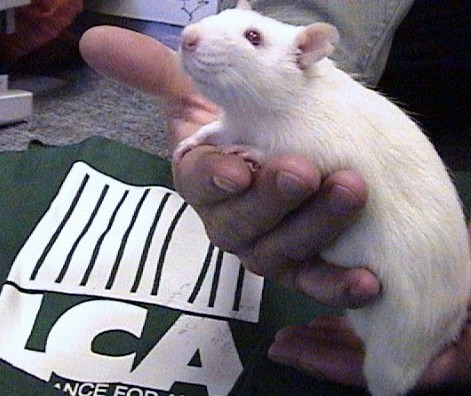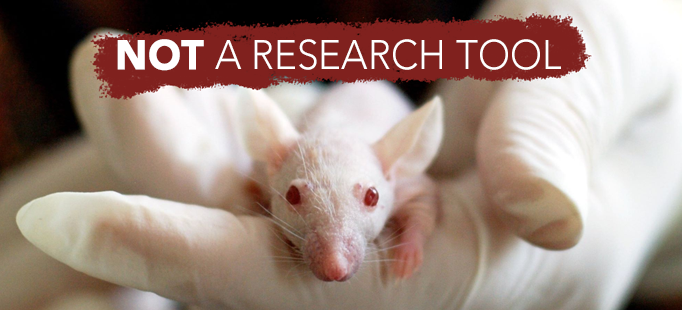Victory: California Bans Cosmetics Tested on Animals
In September 2018, Governor Jerry Brown signed SB 1249 into law, making it illegal to sell products in California that were tested on animals. The law, which goes into effect January 1, 2020, makes California the first state in the nation to enact such a ban.
Dissection
 Dissection is the cutting into of a dead animal to learn about the anatomy or physiology of the animal. It involves cutting into a dead animal while vivisection entails cutting into or dissecting a live animal. Over six million animals are killed for the dissection industry each year.
Dissection is the cutting into of a dead animal to learn about the anatomy or physiology of the animal. It involves cutting into a dead animal while vivisection entails cutting into or dissecting a live animal. Over six million animals are killed for the dissection industry each year.
Animals used for dissection:
- Frogs (especially bullfrogs and leopard frogs)
- Mice
- Rats
- Worms
- Cats
- Rabbits
- Fetal pigs
- Dogs
- Pigeons (and other birds)
- Turtles
- Salamanders
- Snakes
- Minks
- Foxes
- Snails
- Perch (and other species of fish)
- Dogfish sharks
- Squid
- Crayfish
- Clams
- Sea stars
- Sea urchins
- Sycha
- Cockroaches
- Grasshoppers
- Sheep
- Cows
Sources of dissected animals:
- THE WILD — The majority are taken from their natural habitats. Many species of amphibians and reptiles, especially frogs, are declining at an alarming rate. Although this decline is caused mostly by habitat destruction and pollution, the removal of species for dissection worsens the problem. Other species generally taken from their natural environment include turtles, snakes, fish (usually perch), dogfish sharks, earthworms, crayfish, salamanders, and most invertebrates.
- BREEDING FACILITIES — Breeding facilities purposely breed animals for dissection.
- SLAUGHTERHOUSES — Fetal pigs, for one, are a "by-product" of the meat packing industry, in which animals are slaughtered for human consumption. They are removed from pregnant sows who will be killed to produce pork.
- FUR RANCHES — Skinned minks, foxes, and rabbits come from fur ranches.
- PET STORES
- SHELTERS AND POUNDS
- ANIMAL DEALERS AND THIEVES — Class B animal dealers obtain cats, dogs, and other animals from “random sources.” Many steal companion animals from their guardian’s backyard and sell the animals to research labs or dissection companies.
- OTHER COUNTRIES — Cats, for instance, have been purchased in Mexico, only to be killed (by being drowned or having their throats slit), then sent to the U.S. for distribution.
What happens to the animals used for dissection?
Some animals, such as amphibians and reptiles, may suffocate or become crushed during transportation to biological supply companies; most of the animals used for dissection are killed and “processed” at such companies. Undercover investigations have revealed animal abuse at biological supply companies. Frogs, for instance, may be piled into bags for days or even weeks while still alive. Rats may be embalmed alive. Cats may be forcibly injected with preserving fluids after being only partially euthanized, thrown into gas chambers, or drowned.
The effect on the environment:
When one type of animal is removed from an ecosystem, the entire food chain is affected. Frogs, for example, naturally consume many insects. With so many frogs disappearing (as a result of habitat destruction, pollution, and dissection), the insect populations have risen substantially. Because there are more insects, there is greater use of pesticides, which can damage the water supply and food chain.
Types of classes in which dissection is taught:
- Biology
- Anatomy
- Physiology
- Zoology
- Miscellaneous science courses
The danger to students
Animals used in dissection are often embalmed with formaldehyde, a chemical preservative which can damage the eyes and cause asthma attacks and bronchitis. Moreover, the chemical has been linked to cancer of the throat, lungs, and nasal passages. Symptoms of formaldehyde exposure include eye, nose, throat, and skin irritation; a persistent cough and other respiratory ailments; a headache; and nausea and dizziness.
Objecting to dissection
If you live in California, Connecticut, Florida, Illinois, Louisiana, Maine, Maryland, Massachusetts, Michigan, New Hampshire, New Jersey, New Mexico, New York, Oregon, Pennsylvania, Rhode Island, Vermont, or Virginia— you have the legal right to refuse to participate in dissection in class!
- Find out if your school or college has a policy excusing concerned students from harming or killing animals. If so, obtain a copy of the policy.
- Ask your professor whether you will be expected to dissect an animal early before the semester starts if possible. Tell him that you do not intend to participate in the dissection(s) because of your "sincerely held religious and moral beliefs about the sanctity of all life." Be firm, calm, and clear when explaining that dissection conflicts with your beliefs. Do not try to argue with him.
- Suggest reasonable alternatives such as writing a paper or preparing a chart.
- Put your request in writing. Make detailed notes and keep all correspondences relating to the matter.
- Ask your professor to please respond promptly to your request. If he does not do so, go to the principal, department head, or dean.
- Talk to other students and go to the professor or department head as a group to explain your objection to dissection.
- Create a petition against dissection in your school and ask other students to sign it. Give copies to the department head, principal, and anyone else you think could help.
- Ask your parent(s) or guardian(s) to write a letter in support of your decision.
- If the department head or dean is similarly unresponsive, contact the national Dissection Hotline at (800) 922-FROG or AnimaLearn at (800) 729-2287.
- Use your campus newspaper and radio station to begin a dialogue about dissection alternatives at your school.
Feel free to contact an animal protection organization at any point; we are here to help!
Alternatives to dissection:
Numerous studies have shown that students using humane alternatives learn as well, if not better than students who dissect.
- Observation of animals in their natural habitat
- Anatomical models such as the “Great American Bullfrog”
- Computer programs such as Visifrog and The Rat Stack
- CD-ROMS such as the Cat Dissection Library CD-ROM, Bio-Lab Invertebrate D-ROM, and the Biology Dissection CD-ROM
- Non-animal projects such as the Bio-Feedback Micro-lab
- Videotapes
- Videodiscs
- Charts
- Transparencies
- Slides
- Books and manuals
- Online virtual dissection kits such as the Whole Frog Project.
The expense
In the long run, dissection alternatives are less expensive than dissecting live animals. Unlike the former, alternatives such as CD ROMS can be used time and time again, therein permitting students to practice the techniques as many times as they need to truly learn the material. In addition, they are typically accompanied by a manual and do not require supplementary tools such as scalpels or dissections pans.
States that have informed student consent laws (K-12):
- California, 1988, Cal. Education Code Section 32255.1-32255.6
- Florida, 2003, Fla. Stat. ch. 233.0674 (2001) 1003.47
- Illinois, 2000, 105 ILCS 5/27-13.1
- New Jersey, 2005,18A:35-4.24 and 18A:35-4.25
- New York, 1994, N.Y. Educ. Law Section 809
- Oregon, 2005, OR REV. STAT. § 337.300
- Pennsylvania, 1992, 24 P.S. § 15-1523
- Rhode Island, 1997, Gen.Laws 1956, § 16-22-20
- Vermont, 2008, 16 V.S.A. § 912
- Virginia, 2004, Va. Code Ann. § 22.1-200.01 (2004)
States with Student Choice Policies:
- Maine, 1989 (State Dept. of Ed policy)
- Maryland, 1997 (the majority of individual county policies)
States with legislation proposing Student Choice:
- Michigan, HB 4218
-
Tennessee, HJR 1077
Read each state’s individual law.
Passing a Student Choice Policy:
- Ask your school district or state Department of Education to adopt a student dissection choice policy. More information.
